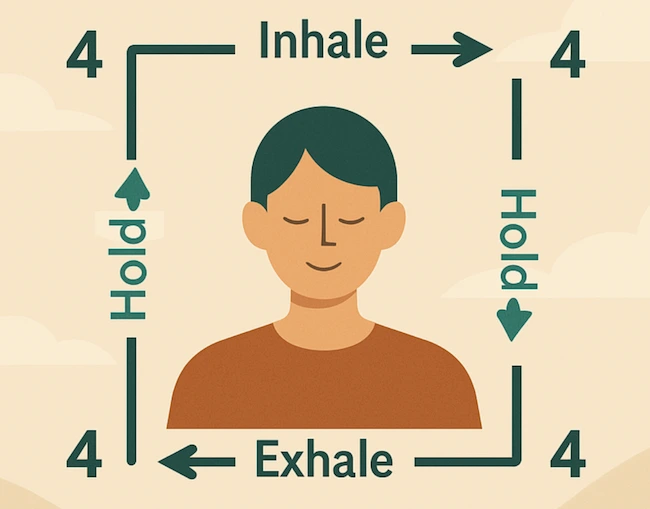Box Breathing: The 4-4-4-4 Technique
Whether you're preparing for sleep, navigating a stressful moment, or just looking for a mindful reset, box breathing offers a steady rhythm to return to.

This technique—also known as square breathing—is used by athletes, performers, and even military personnel to help regulate the nervous system, sharpen focus, and regain a sense of control. But you don’t need to be under extreme pressure to benefit. Box breathing is for everyone.
By intentionally guiding your inhale, hold, exhale, and hold again—all for the same length of time—you gently activate the parasympathetic nervous system, which helps shift your body into a calmer, more balanced state.
What Is Box Breathing?
Box breathing—also known as four-square breathing—is a simple yet powerful breath control technique where each phase of the breath cycle lasts the same amount of time. Typically, this means:
- Inhale – 4 seconds
- Hold – 4 seconds
- Exhale – 4 seconds
- Hold – 4 seconds
The even rhythm forms a “box” shape if you were to chart it visually—hence the name.
The structured format makes it easy to learn and repeat. While this method is now widely used in military, athletic, and clinical settings, it traces its roots to samavritti pranayama, an ancient yogic practice of equal-ratio breathing that has been used for thousands of years to steady the mind and regulate the nervous system.
Benefits of Box Breathing
- Calms the nervous system: Slow, regulated breathing helps reduce sympathetic arousal (the "fight or flight" response) and encourages a state of calm.
- Reduces stress and anxiety: Box breathing has been shown to reduce heart rate and cortisol levels and improve stress regulation over time.
- Improves focus and emotional regulation: The even rhythm gives your mind something concrete to follow. This helps quiet mental noise and improves emotional flexibility, especially in tense moments.
How It Affects the Body and Mind
Box breathing taps into your autonomic nervous system—the part of your body that controls involuntary functions like heart rate, digestion, and the stress response. When you breathe slowly and evenly, you send a signal to your brain: it’s safe to relax.
This kind of controlled breathing activates the parasympathetic nervous system, often called the “rest and digest” mode, which counteracts the body’s stress response.
When practiced regularly, box breathing helps your body and mind respond more flexibly to stress. Instead of reacting with tension or panic, you learn to create a pause—a moment to return to your breath and move forward with more clarity.
How to Practice Box Breathing
- Find a comfortable seat or lie down.
- Close your eyes or soften your gaze.
- Inhale slowly through your nose for 4 counts.
- Hold your breath for 4 counts.
- Exhale gently for 4 counts.
- Hold your breath again for 4 counts.
- Repeat the cycle for 4 rounds—or as long as it feels good.
You can count silently, trace a square with your finger, or tap your fingers—whatever helps you stay present.
Final Thoughts
You don’t need to wait until you’re stressed to try box breathing. Practice during quiet moments—before sleep, on a walk, between tasks—and let it become a grounding part of your routine.
This simple rhythm can be a powerful anchor. It doesn’t take long, but it can change the way you move through your day—calmer, clearer, more present.
